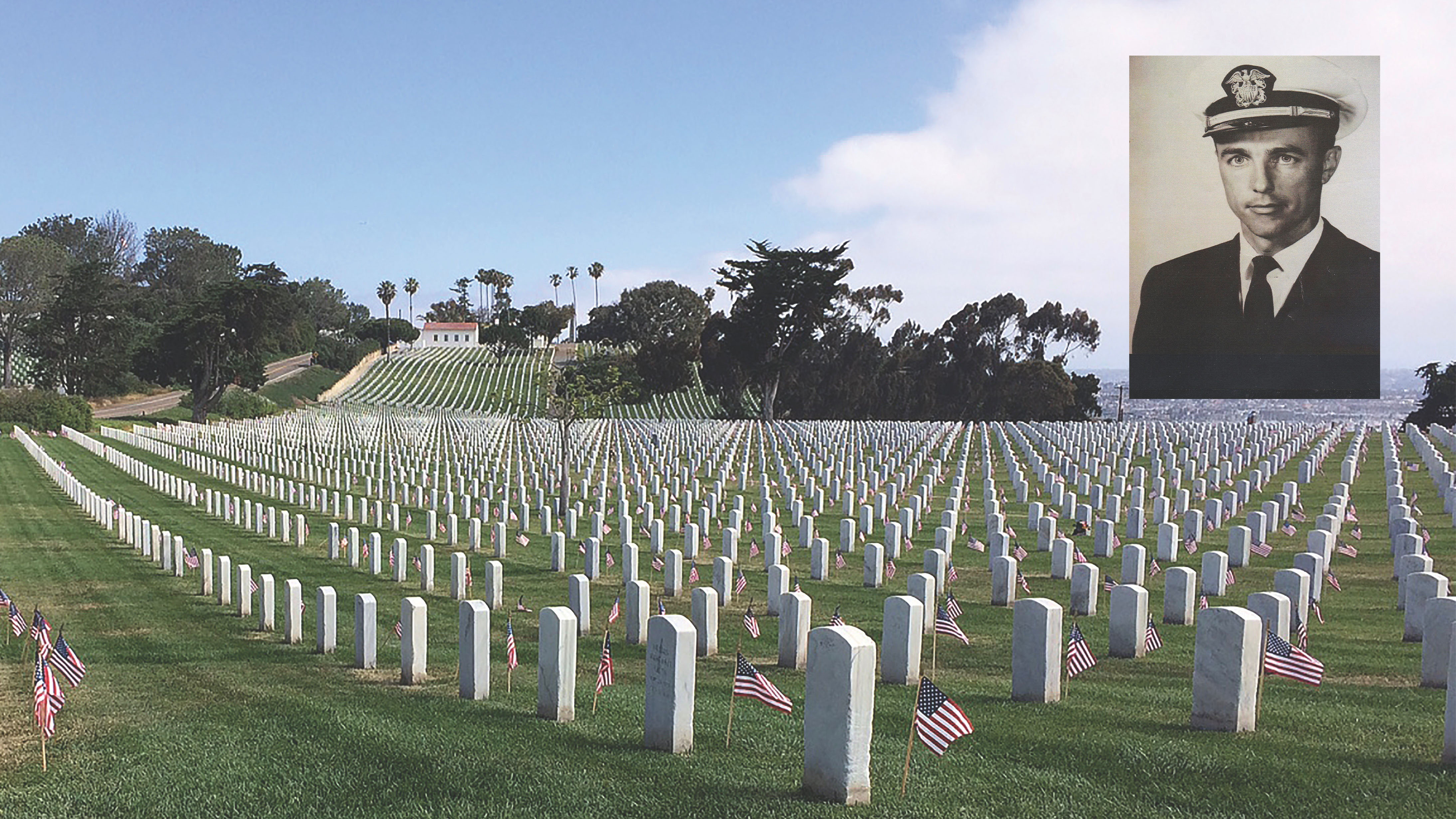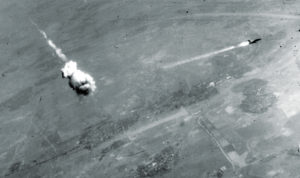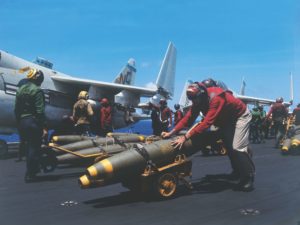More than 50 years after being shot down, a Navy pilot is honored for his sacrifice
The inscription on the white marble headstone of Lt. Cmdr. Frederick Peter Crosby, whose remains were buried in Fort Rosecrans National Cemetery in San Diego on Memorial Day weekend in 2017, reads simply: “NOW HE IS HOME.”
Crosby was home 52 years after being shot down over North Vietnam and listed as dead but also considered missing in action because his remains had not been recovered. On a beautiful Sunday morning along the rolling hillside of Fort Rosecrans overlooking San Diego Bay, Crosby was given a funeral with full military honors attended by no less than 300 people. Many were friends who came to support the family, but others were paying their respects to a decorated Navy pilot killed while serving his country.
Following an emotional 40-minute ceremony that included a nerve-shattering three-volley gun salute from seven Navy riflemen, four F/A-18 Super Hornet fighter jets in perfect formation executed the missing man flight honoring a fallen aviator. Crosby’s headstone will be among the thousands of white marble monuments precisely aligned in a cemetery groomed to perfection.
On June 1, 1965, Crosby and his wingman had taken off from the aircraft carrier USS Bon Homme Richard and were flying unarmed RF-8A Crusader reconnaissance planes on a dangerous photo mission over North Vietnam, made even more dangerous because of low clouds and poor visibility. On a low approach to photograph an important bridge about 20 miles south of Hanoi, groundfire erupted, and soon Crosby’s stricken jet crashed at high speed into a small fish pond. His wingman survived the mission.
Crosby was 31. He and his wife, Mary, had been married for 10 years. They had four children, Douglas, age 8; Deborah, 6; Steven, 4; and John, 2. The lieutenant commander was also survived by an older brother, David, and a sister, Sharon. Crosby’s wife and children lived in the San Diego area during the pilot’s deployment at sea. Douglas, Steven and John still live there.
Frederick Peter Crosby was born June 15, 1933, the son of Lowell and Dena Crosby of Lockport, New York. An avid model airplane builder and aviation enthusiast, he wanted to be a pilot someday, most particularly a Navy pilot. He attended the University of Florida in Gainesville but left when he was accepted into the Navy’s flight training program. He later received a degree in naval science.
The Crosby family—like the families of many Americans whose loved ones were missing after the war ended—had a long journey to endure before they could lay their hero to rest. First, the remains had to be found. American search teams have been allowed in Vietnam only since 1988 and conduct joint searches with Vietnamese counterparts, but access to some sites has been restricted. Even with Vietnamese cooperation, plenty of difficulties confront recovery efforts. The investigators don’t have unlimited funds and often know only the general coordinates of crash sites, which might not look like they did during the war years.
Nevertheless, Deborah Crosby refused to accept the near impossible and pursued the quest for her father’s remains with dogged research and untiring efforts. Investigators from the Defense POW/MIA Accounting Agency, housed within the U.S. Defense Department, were also in pursuit of Crosby’s remains. They made multiple trips to the suspected location of the crash.
The area was covered in vegetation, and the wreckage had been removed many years earlier. The Defense Department team, however, had the good fortune of meeting an 89-year-old farmer who was so close to the crash that he was splashed with mud and water when the plane plunged into the pond. The searchers used buckets to empty the pond and spent days sifting through mud and slime before finding Crosby’s wedding ring and cigarette lighter. Greatly encouraged, the searchers continued until they uncovered several bone fragments, mainly from one of Crosby’s hip bones. That was enough, and after DNA testing at a Defense Department lab in Hawaii, using sister Sharon’s DNA, a positive identification was made.
On the Friday afternoon before Memorial Day 2017, Delta Flight 1687 from Hawaii arrived at San Diego International Airport. In keeping with Delta’s tradition of showing respect for returning military remains, the captain asked all passengers to stay seated until Cosby’s flag-draped casket was removed. There were no passenger complaints.
Standing on the tarmac were Crosby’s sons Douglas, Steven and John, daughter Deborah, brother David and sister Sharon. Mary Crosby, who never remarried and died in 2002, was surely there in spirit. Now the long-awaited closure had begun. Delta’s volunteer honor guard and six sailors in dress white uniforms stood at attention while the family had all the time they wanted to welcome Peter home. Later the six sailors, with military precision, escorted the casket to the Fort Rosecrans chapel, where it would remain until Sunday’s ceremony.
At precisely 10:30 a.m. on May 28, a white horse pulling a black caisson with Crosby’s casket began its journey to the vestibule. On each side of the roadway, standing at attention and holding American flags, were about 20 members of the Patriot Guard Riders, an all-veteran motorcycle group whose mission is to show honor and respect to fallen warriors. Basically unnoticed but there paying his respects was another Vietnam veteran, John P. Baca, a Medal of Honor recipient who served with the 1st Cavalry Division (Airmobile) in 1970. After the ceremony, he said, “I just had to be here.” As hard as he tried to not show it, you could see that his emotions were fragile.
Prayers were said, speeches were made, taps was blown, but it was the American flag now precisely folded and being presented to Deborah that caused tears in most everyone’s eyes. With the ceremony concluded, it was time to place Lt. Cmdr. Frederick Peter Crosby in his final resting place, and for this it was requested only his immediate family be present.
Thomas R. Messick, a retired Army major, served for 28 years as an Army aviator, including two tours in Vietnam. Later he retired as manager of flight operations and chief helicopter pilot for General Electric Co.





